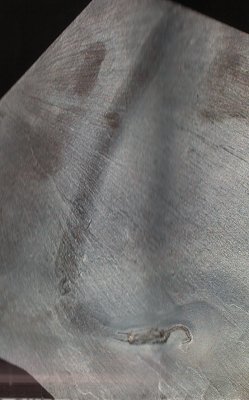
Details of the paper
| Title | Ichnological insights into mitrate palaeobiology |
| Co-Author(s) | Imran A. Rahman, Richard P.S. Jefferies & Ru D.A. Smith |
| Year: | 2009 |
| Language: | English |
| Source: | Palaeontology, Vol. 52 (1): 127-138 |
| Keywords: | Mitrates, Rhenocystis, phylogenetic position, ichnofossils, Hunsrück Slate |
| Summary: | As a sequel to the study from 2000 (see above), an overlooked trace on the original slab and three new slabs from Bundenbach with Rhenocystis-associated trace fossils are described. Unfortunately, further sedimentological analysis shows that the mitrate is preserved in the life position predicted by the "calcichordate" hypothesis (with the flat surface of the body upward) on only one of these slabs (the way-up of the fourth slab is indeterminate). However, the new findings clearly demonstrate that the mitrate appendage was used in locomotion and that this movement took place appendage first. This agrees with the deduced functional morphology. On these grounds, the phylogenetic interpretation of mitrates as crown-group echinoderms is rejected. The two morphotypes (body/spines and appendage) of the mitrate traces are described as Vadichnites transversus igen. et isp. nov. |
| Reaction 1: | Álvaro et al. 2013, in their paper: "The role of abiotic factors in the Cambrian Substrate Revolution: A review from the benthic community replacements of West Gondwana" in Earth-Science Reviews, cite this paper as evidence that at least some stylophorans were able to move because they have been found associated with trace fossils. |
| Reaction 2: | Lin et al. (2010) in their paper "Bioturbation in Burgess Shale-type Lagerstätten: Case study of trace fossil-body fossil association from the Kaili Biota (Cambrian Series 3), Guizhou, China" (Palaeogeography, Palaeoclimatology, Palaeoecology 292: 245-256) refer to the documented direct associations between echinoderms and trace fossils described by Rahman et al. (2009). |
| Reaction 3: | Rahman & Lintz (2012) in their paper "Dehmicystis globulus, an enigmatic solute (Echinodermata) from the Lower Devonian Hunsrück Slate, Germany" (Paläontologische Zeitschrift 86(1): 59-70) mention the very few cases, in which direct associations between ichnofossils and their echinoderm tracemakers have ever been reported. |

[Home] [Book - Life in Devonian] [Contact]
| Homepage last update: 26.04.2024 © ´2024 Südkamp - Exkursionen | wouter(x)suedkamp-exkursionen.de Impressum Datenschutz |
Webmaster: peter.holze(x)hunsnet.de |